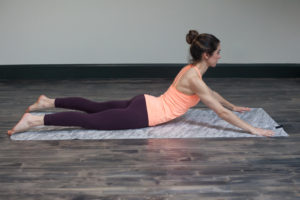Runners are often exposed to repetitive movements and strains on the body. This predominantly leads to lower body injuries, but these can then transpire to the lower back too. Low back pain in runners is often unlikely a serious pathology, but due to an imbalance in their muscle support of the legs, and increased sensitisation to the back.
What is sensitisation?
There are many structures in the back that display sensation of pain and over time the back can display sensitisation. This occurs due to the nerve endings in the muscle, tendon, or ligament becoming increasingly sensitive; therefore they require less input for them to fire nerve impulses to the brain and a pain sensation to be felt. They also produce a greater output, so a small stretch that previously would not have caused pain can trigger a much larger cascade of nerve impulses to the brain and severe pain is felt that is disproportional to the tissue damage. This is shown in diagram one. The back is a strong, stable structure that requires significant trauma to exhibit proper damage,
Therefore runners with back pain are more likely suffering with sensitisation and imbalance of the muscles and their capacity, rather than a serious condition.
Here are a number of tests to try to identify where your weaknesses may be:
Key single leg tests
Single leg support in running is vital because there are no periods when both feet are on the ground. Muscle activity is greater at the transition from the swing to the stance phase (ie. the preparation for ground contact and upon contact), therefore the legs require more strength to absorb this force on landing and reduce transmission up the leg to the pelvis and lower back.
-Single leg stand: Aim to achieve a minimum of 20 seconds, keeping your pelvis neutral.
-Single leg squat: Aim for 10 repetitions with good control and alignment of the hip, knee and ankle each time.
-Single leg hop: Aim for 10 repetitions with good control and balance on landing, as well as alignment of hip, knee, and ankle.
Pelvis movement
Once leg control and balance is established, lumbar movement and control should be assessed. Pelvic tilting is a movement used to achieve lumbar-pelvic dissociation, meaning you can move these two regions of the lower back and pelvis in relation to each other. This allows segmental movement within the vertebrae and reduces stiffness, as well as allowing the intervertebral discs to provide shock absorption. The spine should also be moved in all directions as pain allows.

Core muscles
The roles of the core muscles are to stabilise the trunk and pelvis, and to transfer the force from the legs to the trunk and upper body. Research has shown that even one episode of low back pain demonstrates a 20% reduction in size of some core muscles within 24 hours, as well as muscle atrophy, increased core fatigue, and delayed activation of the core muscles. Here is a previous post on core training for runners.
Gluteal strength
Running produces a ground reaction force of approximately 1.3-5 times bodyweight, as well as an internal compressive force to the leg of approximately 10-14 times bodyweight. This requires a very high level of absorption by the leg muscles. Even with these absorptions, the lumbar spine is subject to 2-5 times bodyweight with each foot strike.
The gluteal muscles absorb three to four times body weight during walking and much more as running speed and power increases.
To strengthen the gluteal muscles try these exercises:
• Lateral step ups
• Single leg squats
• Skater squats (squat on one leg with the other leg diagonally out behind you)
Calf muscle strength
The calf muscles need to absorb up to 8 times your body weight in running and they need to absorb the load in a quick, reactive manner, as well as have the endurance to withstand the repetitive load over long run durations.
Try these calf loading exercises to improve your calf strength and endurance:
Standing heel raises: 2 x 25 repetitions
3 x 30 hops on both feet
3 x 5 single leg hops moving forwards & backwards, on each leg
Read more about Running Injury Rehab & Prevention, Warming Up, and Cooling Down here.




